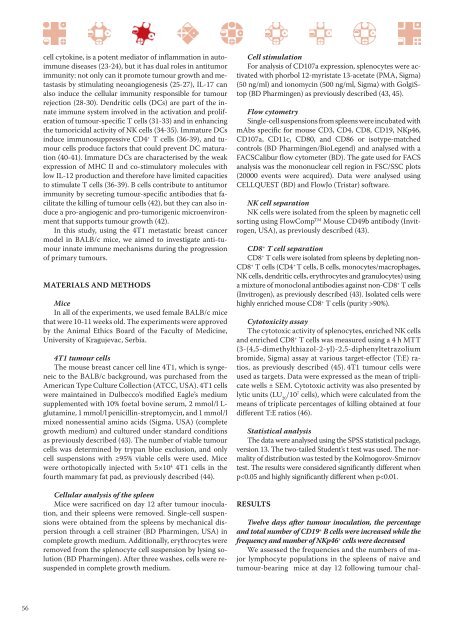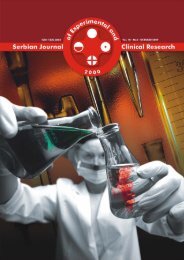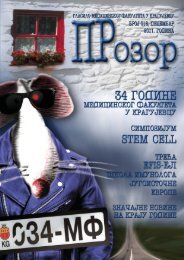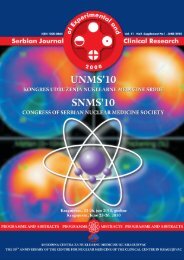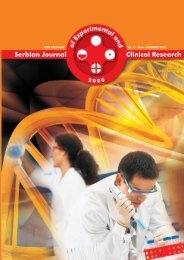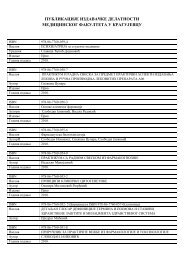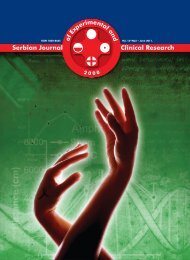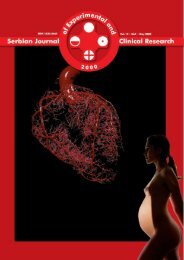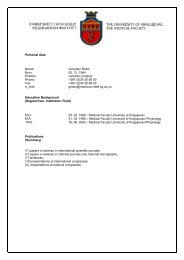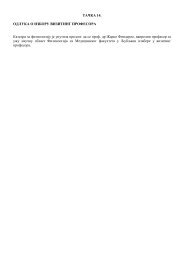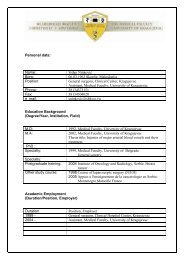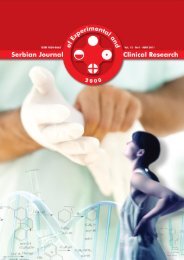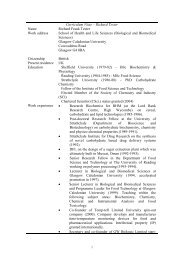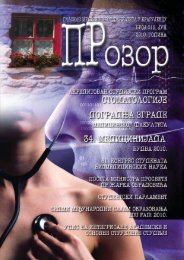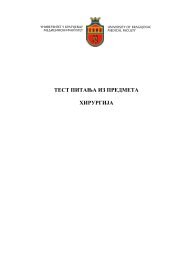Untitled - Medicinski fakultet Kragujevac - Univerzitet u Kragujevcu
Untitled - Medicinski fakultet Kragujevac - Univerzitet u Kragujevcu
Untitled - Medicinski fakultet Kragujevac - Univerzitet u Kragujevcu
You also want an ePaper? Increase the reach of your titles
YUMPU automatically turns print PDFs into web optimized ePapers that Google loves.
56<br />
cell cytokine, is a potent mediator of inflammation in autoimmune<br />
diseases (23-24), but it has dual roles in antitumor<br />
immunity: not only can it promote tumour growth and metastasis<br />
by stimulating neoangiogenesis (25-27), IL-17 can<br />
also induce the cellular immunity responsible for tumour<br />
rejection (28-30). Dendritic cells (DCs) are part of the innate<br />
immune system involved in the activation and proliferation<br />
of tumour-specific T cells (31-33) and in enhancing<br />
the tumoricidal activity of NK cells (34-35). Immature DCs<br />
induce immunosuppressive CD4 + T cells (36-39), and tumour<br />
cells produce factors that could prevent DC maturation<br />
(40-41). Immature DCs are characterised by the weak<br />
expression of MHC II and co-stimulatory molecules with<br />
low IL-12 production and therefore have limited capacities<br />
to stimulate T cells (36-39). B cells contribute to antitumor<br />
immunity by secreting tumour-specific antibodies that facilitate<br />
the killing of tumour cells (42), but they can also induce<br />
a pro-angiogenic and pro-tumorigenic microenvironment<br />
that supports tumour growth (42).<br />
In this study, using the 4T1 metastatic breast cancer<br />
model in BALB/c mice, we aimed to investigate anti-tumour<br />
innate immune mechanisms during the progression<br />
of primary tumours.<br />
MATERIALS AND METHODS<br />
Mice<br />
In all of the experiments, we used female BALB/c mice<br />
that were 10-11 weeks old. The experiments were approved<br />
by the Animal Ethics Board of the Faculty of Medicine,<br />
University of <strong>Kragujevac</strong>, Serbia.<br />
4T1 tumour cells<br />
The mouse breast cancer cell line 4T1, which is syngeneic<br />
to the BALB/c background, was purchased from the<br />
American Type Culture Collection (ATCC, USA). 4T1 cells<br />
were maintained in Dulbecco’s modified Eagle’s medium<br />
supplemented with 10% foetal bovine serum, 2 mmol/l Lglutamine,<br />
1 mmol/l penicillin-streptomycin, and 1 mmol/l<br />
mixed nonessential amino acids (Sigma, USA) (complete<br />
growth medium) and cultured under standard conditions<br />
as previously described (43). The number of viable tumour<br />
cells was determined by trypan blue exclusion, and only<br />
cell suspensions with ≥95% viable cells were used. Mice<br />
were orthotopically injected with 5×10 4 4T1 cells in the<br />
fourth mammary fat pad, as previously described (44).<br />
Cellular analysis of the spleen<br />
Mice were sacrificed on day 12 after tumour inoculation,<br />
and their spleens were removed. Single-cell suspensions<br />
were obtained from the spleens by mechanical dispersion<br />
through a cell strainer (BD Pharmingen, USA) in<br />
complete growth medium. Additionally, erythrocytes were<br />
removed from the splenocyte cell suspension by lysing solution<br />
(BD Pharmingen). After three washes, cells were resuspended<br />
in complete growth medium.<br />
Cell stimulation<br />
For analysis of CD107a expression, splenocytes were activated<br />
with phorbol 12-myristate 13-acetate (PMA, Sigma)<br />
(50 ng/ml) and ionomycin (500 ng/ml, Sigma) with GolgiStop<br />
(BD Pharmingen) as previously described (43, 45).<br />
Flow cytometry<br />
Single-cell suspensions from spleens were incubated with<br />
mAbs specific for mouse CD3, CD4, CD8, CD19, NKp46,<br />
CD107a, CD11c, CD80, and CD86 or isotype-matched<br />
controls (BD Pharmingen/BioLegend) and analysed with a<br />
FACSCalibur flow cytometer (BD). The gate used for FACS<br />
analysis was the mononuclear cell region in FSC/SSC plots<br />
(20000 events were acquired). Data were analysed using<br />
CELLQUEST (BD) and FlowJo (Tristar) software.<br />
NK cell separation<br />
NK cells were isolated from the spleen by magnetic cell<br />
sorting using FlowComp TM Mouse CD49b antibody (Invitrogen,<br />
USA), as previously described (43).<br />
CD8 + T cell separation<br />
CD8 + T cells were isolated from spleens by depleting non-<br />
CD8 + T cells (CD4 + T cells, B cells, monocytes/macrophages,<br />
NK cells, dendritic cells, erythrocytes and granulocytes) using<br />
a mixture of monoclonal antibodies against non-CD8 + T cells<br />
(Invitrogen), as previously described (43). Isolated cells were<br />
highly enriched mouse CD8 + T cells (purity >90%).<br />
Cytotoxicity assay<br />
The cytotoxic activity of splenocytes, enriched NK cells<br />
and enriched CD8 + T cells was measured using a 4 h MTT<br />
(3-(4,5-dimethylthiazol-2-yl)-2,5-diphenyltetrazolium<br />
bromide, Sigma) assay at various target-effector (T:E) ratios,<br />
as previously described (45). 4T1 tumour cells were<br />
used as targets. Data were expressed as the mean of triplicate<br />
wells ± SEM. Cytotoxic activity was also presented by<br />
lytic units (LU 20 /10 7 cells), which were calculated from the<br />
means of triplicate percentages of killing obtained at four<br />
different T:E ratios (46).<br />
Statistical analysis<br />
The data were analysed using the SPSS statistical package,<br />
version 13. The two-tailed Student’s t test was used. The normality<br />
of distribution was tested by the Kolmogorov-Smirnov<br />
test. The results were considered significantly different when<br />
p


